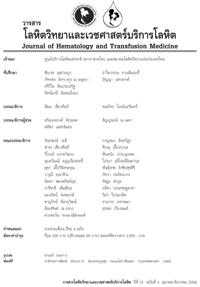ภาวะเกล็ดเลือดต่ำในหญิงตั้งครรภ์ที่โรงพยาบาลพระมงกุฎเกล้า
Keywords:
เกล็ดเลือดต่ำ, หญิงตั้งครรภ์, Gestational thrombocytopenia, Thrombocytopenia, Pregnancy,Abstract
บทคัดย่อ
ในหญิงตั้งครรภ์ภาวะเกล็ดเลือดต่ำเกิดขึ้นประมาณร้อยละ 8 สาเหตุที่พบบ่อย คือ gestational thrombocytopenia รองลงมาได้แก่ preeclampsia/HELLP syndrome และ immune thrombocytopenia ตามลำดับ ซึ่งข้อมูลในประเทศไทยเกี่ยวกับเรื่องนี้ค่อนข้างจำกัด วัตถุประสงค์ : เพื่อศึกษาหญิงตั้งครรภ์ที่ตรวจพบว่ามีเกล็ดเลือดต่ำที่โรงพยาบาลพระมงกุฎเกล้า โดยศึกษาถึงสาเหตุ ปัจจัยเสี่ยงทางสูติกรรม ผลแทรกซ้อนและผลลัพธ์ของการตั้งครรภ์ วัสดุและวิธีการ : เป็นการศึกษาเชิงพรรณนาแบบย้อนหลังในผู้หญิงตั้งครรภ์ 65 รายซึ่งมีภาวะเกล็ดเลือดต่ำที่โรงพยาบาลพระมงกุฎเกล้าฯ ตั้งแต่ปี พ.ศ.2548-2553 ผลการวิจัย : สาเหตุหลักที่ทำให้เกล็ดเลือดต่ำในหญิงตั้งครรภ์ เกิดจาก gestational thrombocytopenia (ร้อยละ 56.9) สาเหตุอื่นๆ รองลงมาได้แก่ preeclampsia/HELLP syndrome (ร้อยละ 27.7) immune thrombocytopenia-ITP (ร้อยละ 7.7) การติดเชื้อ HIV ร้อยละ 3.1 และสาเหตุที่พบไม่บ่อย ได้แก่ disseminated intravascular coagulation (ร้อยละ 1.5) และ systemic lupus erythematosus (ร้อยละ 1.5) เมื่อดูระดับเกล็ดเลือด พบว่าผู้ป่วยส่วนใหญ่ (ร้อยละ 72.3) มีภาวะเกล็ดเลือดต่ำเล็กน้อย (100 -149 x109/L) แต่ในกลุ่ม ITP มักมีเกล็ดเลือดต่ำรุนแรงเฉลี่ย 25 x109/L (7-44 x 109/L) การตั้งครรภ์ในผู้หญิงสูงอายุ (elderly pregnancy) เป็นปัจจัยเสี่ยงของการตั้งครรภ์ที่พบมากที่สุด เมื่อขณะคลอด พบว่าผู้ป่วยส่วนมาก(ร้อยละ 58.5) มีเลือดออกเพียงเล็กน้อย (< 500 มิลลิลิตร) มีเพียง 2 รายจาก gestational thrombocytopenia ที่มีภาวะเลือดออกมากกว่า 1 ลิตร สาเหตุเกิดจากมดลูกไม่บีบตัว มีทารกแรกคลอดที่มี Apgar score น้อยกว่า 7 ที่ 1 นาที ร้อยละ 9.2 แต่ไม่มีทารกที่มี Apgar score น้อยกว่า 7 เลยเมื่อนาทีที่ 5 หลังคลอด ไม่มีทารกที่เสียชีวิตก่อนคลอดและหลังคลอด พบว่า preeclampsia/HELLP syndrome สัมพันธ์กับการเกิดทารกน้ำหนักแรกคลอดน้อย (ร้อยละ 47.4) อย่างมีนัยสำคัญทางสถิติ มีผู้ป่วย 9 คนที่ได้รับส่วนประกอบของเลือด ซึ่งร้อยละ 80 อยู่ในกลุ่ม ITP สรุป : Gestational thrombocytopenia เป็นสาเหตุที่พบบ่อยที่สุดในหญิงตั้งครรภ์ที่มีเกล็ดเลือดต่ำpreeclampsia/HELLP syndrome สัมพันธ์กับการเกิดทารกแรกคลอดน้ำหนักน้อย และ ITP อาจมีเกล็ดเลือดต่ำรุนแรงและเป็นสาเหตุหลักที่ผู้ป่วยมักได้รับการรักษาโดยการให้ส่วนประกอบของเลือด
Key Words : เกล็ดเลือดต่ำ; หญิงตั้งครรภ์ ; Gestational thrombocytopenia
Abstract
Thrombocytopenia occurs in approximately 8% of pregnant women. The most common cause is gestational thrombocytopenia (GT), followed by preeclampsia/HELLP syndrome and immune thrombocytopenic purpura (ITP), respectively. However, the data in Thailand is limited. Objective : To investigate the causes, obstetric risk factors, complications and outcomes of pregnancies complicated by thrombocytopenia. Material and Method : A retrospective descriptive study was performed in 65 pregnant women with thrombocytopenia (platelet count below 150 x 109/L) from January 2005 to April 2010. Results : The most common cause of thrombocytopenia is gestational thrombocytopenia (GT). Other etiologies are preeclampsia/HELLP syndrome (27.7%), immune thrombocytopenia (ITP, 7.7%) and HIV infection (3.1%). The less common causes are disseminated intravascular coagulation (DIC) and systemic lupus erythrematosus (SLE) (1.5% each). Most of the patients (72.3%) have mild thrombocytopenia (platelet count 100-150 x 109/L). However, thrombocytopenia is more severe (mean 25 x 109/L; range 7-44 x 109/L) in ITP. Elderly pregnancy is the most common obstetric risk factor. Most of these cases (58.5%) have minimal blood loss (< 500 mL), while 2 patients with GT have massive blood loss (> 1,000 mL) due to uterine atony. For neonatal outcomes, 9.2% of neonates have Apgar score < 7 at 1 min, but none of them has Apgar score < 7 at 5 min. Neither intra-partum fetal death nor post-partum neonatal death occurs. Preeclampsia/HELLP syndrome is the most common (47.4%) cause of low birth weight (< 2,500 g). Nine patients required blood transfusion and 80% of them have ITP. Conclusion : Gestational thrombocytopenia is the most common cause of thrombocytopenia in pregnancy. Preeclampsia/HELLP syndrome is associated with a low birth weight. ITP may have severe thrombocytopenia and is the most common cause of transfusion requirement.
Key Words : Thrombocytopenia ; Pregnancy ; Gestational thrombocytopenia



